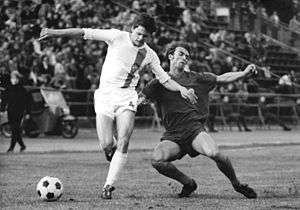Lutz Eigendorf
Lutz Eigendorf (16 July 1956 – 7 March 1983) was a German football player.
 Eigendorf (left) playing for BFC Dynamo in 1975 | |||
| Personal information | |||
|---|---|---|---|
| Date of birth | 16 July 1956 | ||
| Place of birth | Brandenburg, East Germany | ||
| Date of death | 7 March 1983 (aged 26) | ||
| Place of death | Braunschweig, West Germany | ||
| Height | 1.82 m (6 ft 0 in) | ||
| Playing position(s) | Midfielder | ||
| Youth career | |||
| –1970 | BSG Motor Süd Brandenburg | ||
| 1970–1974 | BFC Dynamo | ||
| Senior career* | |||
| Years | Team | Apps | (Gls) |
| 1974–1979 | BFC Dynamo | 100 | (7) |
| 1980–1982 | 1. FC Kaiserslautern | 53 | (7) |
| 1982–1983 | Eintracht Braunschweig | 8 | (2) |
| National team | |||
| 1978–1979 | East Germany | 6 | (3) |
| * Senior club appearances and goals counted for the domestic league only | |||
GDR career
The talented Eigendorf played for East German side BFC Dynamo. He made 100 East German top-flight appearances.[1]
Defection to the West
BFC Dynamo travelled to West Germany to play a friendly match against 1. FC Kaiserslautern on 20 March 1979. The team made a visit to the city of Gießen the day after the match, on their return trip to East Berlin. During their visit, Lutz Eigendorf managed to escape from the rest of the team. He jumped into a taxi and fled back to Kaiserslautern,[3] thereby defecting to the West, hoping to play for the football team. But because of his defection he was banned from play for one year by UEFA and instead spent that time as a youth coach with the club.
This was not the first time an East German athlete had fled to the west, but it was a particularly embarrassing defection. Eigendorf's club BFC Dynamo was under the patronage of the Stasi, East Germany's secretive state police, and subject to the personal attentions of the organisation's head, Erich Mielke. After his defection Eigendorf openly criticised East Germany in the western media.
His wife Gabriele remained behind in Berlin with their daughter and was placed under constant police surveillance. Lawyers working for the Stasi quickly arranged a divorce and Gabriele Eigendorf remarried. Her new husband was eventually revealed as a Lothario – an agent of the state police whose role it was to spy on a suspect while romancing them.
Death under suspicious circumstances
In 1983, Eigendorf moved from Kaiserslautern to join Eintracht Braunschweig, all the while under the scrutiny of the Stasi who employed a number of West Germans as informants. On 5 March of that year, he was badly injured in a suspicious traffic accident in which he had driven his car into a tree. Apparently, a large truck had blinded him by turning on its main headlights just as Eigendorf was approaching a curve. He died at the hospital within two days. An autopsy indicated a high blood alcohol level despite the testimony of people he had met with that evening which indicated that Eigendorf had only drunk a small amount of beer. The police ruled the case an accident and Eigendorf was buried without autopsy.
Investigation into suspected assassination
After German re-unification and the subsequent opening of the files of the former East Germany's state security service, the public prosecutor's office in Berlin started an investigation into the possible murder of Lutz Eigendorf by the Stasi, but in 2004, the case was closed, and in 2011, despite public pressure, it was not reopened as the public prosecutor's office did not see any objective evidence of any third-party involvement and the suspicion of a contract killing could not be corroborated, leaving the case unsolved.[4] A summary report of the events surrounding Eigendorf's death was made on German television on 22 March 2000 which detailed an investigation by Heribert Schwan in the documentary Tod dem Verräter (Death to the Traitor).[5]
On 10 February 2010, a former East German spy revealed the Stasi ordered him to kill Eigendorf, which he personally claimed not to have done.[6][3]
References
- Arnhold, Matthias (26 February 2020). "Lutz Eigendorf - Matches and Goals in Oberliga". RSSSF.com. Retrieved 26 February 2020.
- Arnhold, Matthias (26 February 2020). "Lutz Eigendorf - International Appearances". RSSSF.com. Retrieved 26 February 2020.
- Petrossian, Shahan. "Tales of Defection: The Cold War's Impact on the Game". theantiquefootball.com. Retrieved 2 April 2019.
- "- Die politische Brisanz falsch eingeschätzt". Deutschlandfunk (in German). Retrieved 14 April 2019.
- Clark Kent (4 December 2016), "Tod dem Verräter" - Der Fall des Lutz Eigendorf, retrieved 14 April 2019
- "Mordauftrag von der StasiDer Fall Lutz Eigendorf" (in German). bild.de. Retrieved 7 February 2011.
External links
- Lutz Eigendorf at WorldFootball.net
- Lutz Eigendorf at National-Football-Teams.com
- The curious case of Lutz Eigendorf – Part 1 – writer: Uli Hesse, from ESPN Soccernet
- The curious case of Lutz Eigendorf – Part 2 – writer: Uli Hesse, from ESPN Soccernet
See also
- List of Eastern Bloc defectors